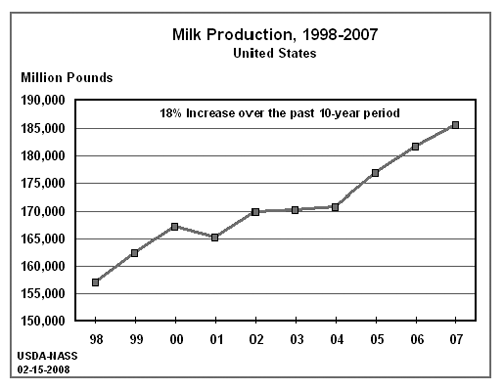
| Previous | Return to table of contents | Search Reports | Next |
| « Back to weltagrarbericht.de | ||
Changes in Agriculture and Food Production in NAE Since 1945 | 51

Figure 2-15. Trends in productivity per cow in US from 1998-2007. Source: USDA-NASS, 2008 |
||
|
||
population in Europe and desire for more meat consumption among North Americans. This drive for greater productivity accelerated in the 1950s as a response to the need to rebuild the food supply chain after World War II. Science-based livestock breeding typically produced annual genetic changes of around 2% of the mean of a trait (or trait-related index), especially in species with high reproductive rates like pigs and poultry (Simm et al., 2005). Not only were yields from livestock varieties substantially increased, but standardized livestock systems were also developed, where in cattle (and to some extent sheep), the landscape was adapted to the system. In pigs and poultry, the whole enterprise was taken off the land and into intensive housing and feeding systems. Varieties that maximized food conversion ratios were quickly developed, especially in pigs and poultry (Simm et al., 2005), with cattle breeding focused almost entirely on high milk and meat production. In N. America in the 1960s and 1970s, the so-called "British Breeds" of cattle were replaced in much of the beef sector by "Continental Breeds" that introduced size and leanness, in response to consumer desire for leaner beef. The genetic techniques used to achieve these productivity gains include: Despite the undoubted success of these science-based breeding programs, it is generally agreed that the maximum genetic potential of cattle, pigs and poultry has still not been |
|
reached and intensive breeding programs are still maintained in Europe although the focus is now shifting away from continued productivity increases towards animal health and welfare traits (Garnsworthy, 2005). |
| Previous | Return to table of contents | Search Reports | Next |
| « Back to weltagrarbericht.de | ||